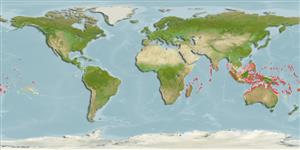Common names from other countries
>
Blenniiformes (Blennies) >
Blenniidae (Combtooth blennies) > Salariinae
Etymology: Cirripectes: Latin, cirrus = curl fringe + Greek, pektos, -e, -on = made of several parts solidly united (Ref. 45335); stigmaticus: From the Greek word 'stigma' meaninf spot or mark, referring to the body markings..
More on authors: Strasburg & Schultz.
Environment: milieu / climate zone / depth range / distribution range
Ecologie
marien rifbewoner; diepte 0 - 20 m (Ref. 529), usually ? - 10 m (Ref. 90102). Tropical; 15°N - 30°S
Indo-Pacific: Kenya south to Mozambique and throughout the Indian Ocean and western central Pacific to the Marshall and Samoan islands.
Lengte bij maturiteit / Grootte / Gewicht / Leeftijd
Maturity: Lm ?, range 5 - ? cm
Max length : 10.0 cm SL mannelijk / geslacht onbekend; (Ref. 529)
Dorsale stekels (totaal): 11 - 13; Dorsale zachte stralen (totaal): 14-16; Anale stekels 2; Anale zachte stralen: 15 - 17; Wervels: 30 - 32. Diagnosis: Dorsal fin XII, 15, membrane attached to caudal fin, with deep notch above last spine, first spine slightly higher than second; anal fin II, 16; pectoral rays 15; pelvic fin I, 4; caudal fin procurrent rays 10-14. Vertebrae 10 + 21. LL, without scales and scalelike flaps; LL tubes 1-10 (usually 3-8), canal ends below 7th dorsal ray to caudal-fin base. Lower lip smooth mesially, plicate laterally. Upper lip crenulae 35-52. Gill rakers 23-30. Cephalic pore system simple; no pores at extra interorbital position; a pore present behind nuchal flap on each side. Cirri, supraorbital 7-22, nasal 8-29; nuchal 34-47, in 4 groups, ventralmost group borne on slightly expanded nuchal flap on each side. Head and body dark brown with scarlet reticulum anteriorly which becomes spots and wavy lines posteriorly; iris with yellow-ringed pupil. Gilbert Island males are darker; pigmentation on fins brown instead of scarlet; iris are almost entirely yellow (Ref. 529). Large individuals are dark green to black with red spots on the head and red spots to vertical streaks on the sides (Ref. 1602).
Facultative air-breathing in the genus (Ref. 126274); Found solitary or forms small groups in the upper edge of seaward reef slopes, less than 10 m, but may be found up to 20 m deep (Ref. 90102). Adults inhabit coastal reef flats with rich coral and algae habitats (Ref. 48636); also on rocky and coralline structures (Ref. 529); among Acropora and Pocillopora corals of surf-swept algal ridge. Oviparous. Eggs are demersal and adhesive (Ref. 205), and are attached to the substrate via a filamentous, adhesive pad or pedestal (Ref. 94114). Larvae are planktonic, often found in shallow, coastal waters (Ref. 94114).
Oviparous, distinct pairing (Ref. 205). Urogenital orifice of male genital papilla located basally between 2 widely separated slender filaments on a fleshy swelling behind anus; testes bulbous with length equal its width (Ref. 529).
Williams, J.T., 1988. Revision and phylogenetic relationships of the blenniid fish genus Cirripectes. Indo-Pac. Fish. (17):78 p. (Ref. 529)
Status op de Rode Lijst van het IUCN (Ref. 130435)
CITES (Ref. 128078)
Not Evaluated
Gevaar voor de mens
Harmless
Gebruik door de mens
Visserij: van geen belang; Aquarium: Commercieel
Meer informatie
ReferentiesAquacultuurAquacultuurprofielKweeklijnenGeneticaElectrophoresesErfelijkheidZiektesVerwerkingMassaconversie
Tools
Speciale rapporten
Download XML
Internetbronnen
Estimates based on models
Preferred temperature (Ref.
115969): 25.7 - 29.3, mean 28.5 (based on 2222 cells).
Fylogenetische diversiteitsindex (Ref.
82804): PD
50 = 0.5000 [Uniqueness, from 0.5 = low to 2.0 = high].
Bayesian length-weight: a=0.01023 (0.00604 - 0.01735), b=3.02 (2.87 - 3.17), in cm Total Length, based on LWR estimates for this species & (Sub)family-body (Ref.
93245).
Trofisch niveau (Ref.
69278): 2.0 ±0.00 se; based on food items.
Weerstandsvermogen (Ref.
120179): Hoog, minimale populatieverdubbelingstijd minder dan 15 maanden (Preliminary K or Fecundity.).
Fishing Vulnerability (Ref.
59153): Low vulnerability (10 of 100).
